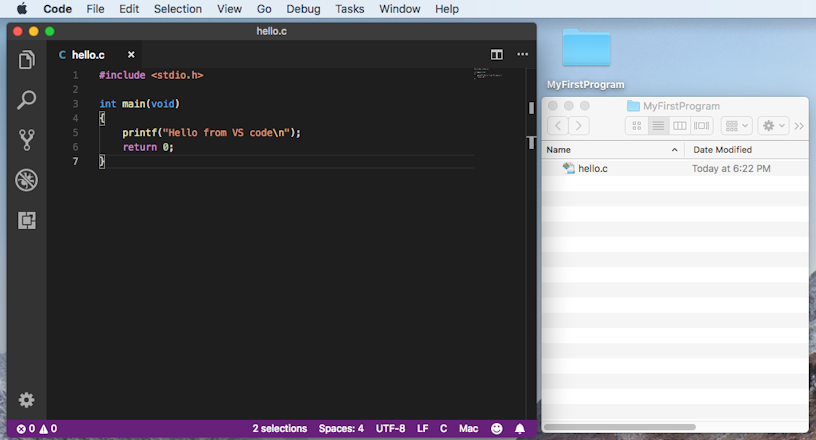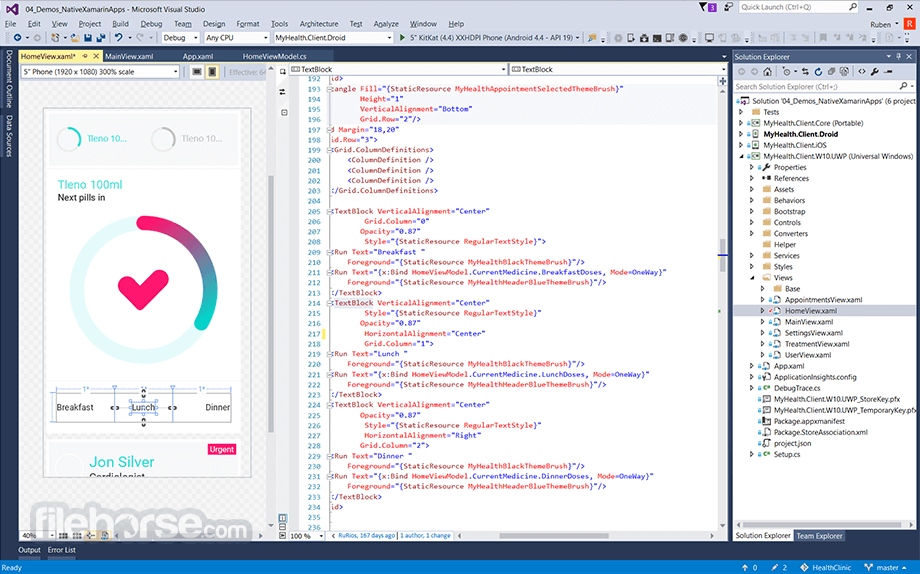This software can be used for free and many features like C compiler, macro assembler, message compiler and code signing utility can be used. It will be able to support 32-bit and 64-bit Windows and it is very popular for different C standards like C99 and C11. Simple, free C/C Programming IDE for Windows. Quincy is listed in Programming IDEs. Link to official Quincy site. Official Website. Features Compiler Debugger Educational IDE Add a feature. Deploying and managing software across the entire software. Free Open Source Mac Windows Linux. C language is one of the most widely used languages in programming. It allows you to create applications on any computer. Qt SDK is a software suite to cross-platform applications. Qt SDK is especially designed to create applications. License: Open Source OS: Windows 7 Windows 8 Windows 10 Mac OS X Language: EN Version: 5.15.
Key Features
Latest Version: 11.2.1
Rated 3/5 By 11,686 People
What does Xcode do? Xcode includes everything developers need to create great applications for Mac, iPhone, iPad, Apple TV, and Apple Watch. Xcode provides developers a unified workflow for user interface design, coding, testing, and debugging. The Xcode IDE combined with the Swift programming language make developing apps easy and fun.Xcode includes the Xcode IDE, Swift and C/C++/Objective-C compilers, Instruments analysis tool, simulators, the latest SDKs, and hundreds of powerful features:Innovative tools help you create great apps• Swift is an intuitive programming language that is safe, fast, and modern• SwiftUI is a revolutionary new framework to create user interfaces with a declarative Swift syntax• Playgrounds are a fun way to experiment and interact with Swift code• View debugging shows a 3D stack of all your app's UI view layers at runtime• Split editors in virtually unlimited ways, show previews, or choose an assistant to see related content• Live Issues display errors as you type, and Fix-its improve your code with just a click• Source control navigator and service integrations help you manage code across a teamSwiftUI and Interface Builder make it easy to design your interface• SwiftUI uses declarative Swift code that clearly describes your interface• Design canvas graphically builds UI views using the library of controls and modifyers• Preview SwiftUI code or UIKit interfaces in different screen sizes, orientations, and font sizes• SwiftUI code is always in perfect sync with the graphical design canvas and previews• Animations are built using simple commands that describe the action you want to seeProfessional editor and debugger keep your code front and center• Refactoring makes it easy to modify the structure of Swift, Objective-C, C, and C++ code• Open Quickly instantly opens any file within your project• Data tips and Quick Look can inspect a variable by hovering your mouse over code while debugging• Third-party app extensions can add new capabilities to the source editorTest driven development is built right in• Use the Test Navigator to add, edit, or run unit tests or user interface tests with just a click• Test Assistant makes it easy to edit your code and related tests, side-by-side• Create continuous integration bots to build and test on a server Mac running XcodeInstruments for performance analysis• Compare CPU, disk, memory, and GPU performance as graphical tracks over time• Identify performance bottlenecks, then dive deep into the code to uncover the cause• Analyze your app directly, or sample the entire system with very little overhead• Create custom instruments with unique visualizations to analyze your own code and frameworksTo test or run applications on an iPhone, iPad, Apple TV, or Apple Watch all you need is a free Apple ID. To submit your apps to the App Store you must be a member of the Apple Developer Program. Some features may require Internet access.
Download for MacOS - server 1 --> Free
Objective-C is the primary programming language you use when writing software for OS X and iOS. It’s a superset of the C programming language and provides object-oriented capabilities and a dynamic runtime. Objective-C inherits the syntax, primitive types, and flow control statements of C and adds syntax for defining classes and methods. It also adds language-level support for object graph management and object literals while providing dynamic typing and binding, deferring many responsibilities until runtime.
At a Glance
This document introduces the Objective-C language and offers extensive examples of its use. You’ll learn how to create your own classes describing custom objects and see how to work with some of the framework classes provided by Cocoa and Cocoa Touch. Although the framework classes are separate from the language, their use is tightly wound into coding with Objective-C and many language-level features rely on behavior offered by these classes.
An App Is Built from a Network of Objects
When building apps for OS X or iOS, you’ll spend most of your time working with objects. Those objects are instances of Objective-C classes, some of which are provided for you by Cocoa or Cocoa Touch and some of which you’ll write yourself.
If you’re writing your own class, start by providing a description of the class that details the intended public interface to instances of the class. This interface includes the public properties to encapsulate relevant data, along with a list of methods. Method declarations indicate the messages that an object can receive, and include information about the parameters required whenever the method is called. You’ll also provide a class implementation, which includes the executable code for each method declared in the interface.
Relevant Chapters:Defining Classes, Working with Objects, Encapsulating Data
Categories Extend Existing Classes

Rather than creating an entirely new class to provide minor additional capabilities over an existing class, it’s possible to define a category to add custom behavior to an existing class. You can use a category to add methods to any class, including classes for which you don’t have the original implementation source code, such as framework classes like NSString.
If you do have the original source code for a class, you can use a class extension to add new properties, or modify the attributes of existing properties. Class extensions are commonly used to hide private behavior for use either within a single source code file, or within the private implementation of a custom framework.
Protocols Define Messaging Contracts
The majority of work in an Objective-C app occurs as a result of objects sending messages to each other. Often, these messages are defined by the methods declared explicitly in a class interface. Sometimes, however, it is useful to be able to define a set of related methods that aren’t tied directly to a specific class.
Objective-C uses protocols to define a group of related methods, such as the methods an object might call on its delegate, which are either optional or required. Any class can indicate that it adopts a protocol, which means that it must also provide implementations for all of the required methods in the protocol.
Relevant Chapters:Working with Protocols
Values and Collections Are Often Represented as Objective-C Objects
It’s common in Objective-C to use Cocoa or Cocoa Touch classes to represent values. The NSString class is used for strings of characters, the NSNumber class for different types of numbers such as integer or floating point, and the NSValue class for other values such as C structures. You can also use any of the primitive types defined by the C language, such as int, float or char.
Collections are usually represented as instances of one of the collection classes, such as NSArray, NSSet, or NSDictionary, which are each used to collect other Objective-C objects.
Blocks Simplify Common Tasks
Blocks are a language feature introduced to C, Objective-C and C++ to represent a unit of work; they encapsulate a block of code along with captured state, which makes them similar to closures in other programming languages. Blocks are often used to simplify common tasks such as collection enumeration, sorting and testing. They also make it easy to schedule tasks for concurrent or asynchronous execution using technologies like Grand Central Dispatch (GCD).
Relevant Chapters:Working with Blocks
Error Objects Are Used for Runtime Problems
Although Objective-C includes syntax for exception handling, Cocoa and Cocoa Touch use exceptions only for programming errors (such as out of bounds array access), which should be fixed before an app is shipped.
All other errors—including runtime problems such as running out of disk space or not being able to access a web service—are represented by instances of the NSError class. Your app should plan for errors and decide how best to handle them in order to present the best possible user experience when something goes wrong.
Objective-C Code Follows Established Conventions
When writing Objective-C code, you should keep in mind a number of established coding conventions. Method names, for example, start with a lowercase letter and use camel case for multiple words; for example, doSomething or doSomethingElse. It’s not just the capitalization that’s important, though; you should also make sure that your code is as readable as possible, which means that method names should be expressive, but not too verbose.
In addition, there are a few conventions that are required if you wish to take advantage of language or framework features. Property accessor methods, for example, must follow strict naming conventions in order to work with technologies like Key-Value Coding (KVC) or Key-Value Observing (KVO).
Relevant Chapters:Conventions
Prerequisites
If you are new to OS X or iOS development, you should read through Start Developing iOS Apps Today (Retired) or Start Developing Mac Apps Today before reading this document, to get a general overview of the application development process for iOS and OS X. Additionally, you should become familiar with Xcode before trying to follow the exercises at the end of most chapters in this document. Xcode is the IDE used to build apps for iOS and OS X; you’ll use it to write your code, design your app's user interface, test your application, and debug any problems.
Although it’s preferable to have some familiarity with C or one of the C-based languages such as Java or C#, this document does include inline examples of basic C language features such as flow control statements. If you have knowledge of another higher-level programming language, such as Ruby or Python, you should be able to follow the content.
Reasonable coverage is given to general object-oriented programming principles, particularly as they apply in the context of Objective-C, but it is assumed that you have at least a minimal familiarity with basic object-oriented concepts. If you’re not familiar with these concepts, you should read the relevant chapters in Concepts in Objective-C Programming.
See Also
Best C Programming Software
The content in this document applies to Xcode 4.4 or later and assumes you are targeting either OS X v10.7 or later, or iOS 5 or later. For more information about Xcode, see Xcode Overview. For information on language feature availability, see Objective-C Feature Availability Index.
Objective-C apps use reference counting to determine the lifetime of objects. For the most part, the Automatic Reference Counting (ARC) feature of the compiler takes care of this for you. If you are unable to take advantage of ARC, or need to convert or maintain legacy code that manages an object’s memory manually, you should read Advanced Memory Management Programming Guide.
In addition to the compiler, the Objective-C language uses a runtime system to enable its dynamic and object-oriented features. Although you don’t usually need to worry about how Objective-C “works,” it’s possible to interact directly with this runtime system, as described by Objective-C Runtime Programming Guide and Objective-C Runtime Reference.
C C++ software, free download
Free Visual C++ Download Software
Copyright © 2014 Apple Inc. All Rights Reserved. Terms of Use | Privacy Policy | Updated: 2014-09-17
